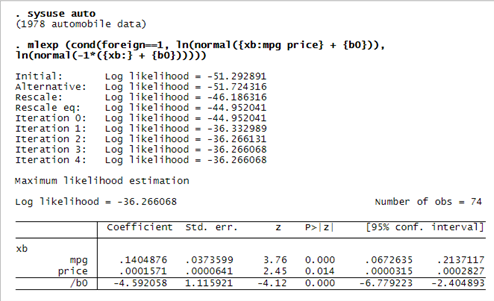HIGHLIGHTS
- Specify log-likelihood function interactively
- Optionally specify first derivatives
- Robust SEs to relax distributional assumptions
- Cluster–robust SEs for correlated data
- Linear and nonlinear postestimation hypotheses tests
SHOW ME
Maximization of user-specified likelihood functions has long been a hallmark of Stata, but you have had to write a program to calculate the log-likelihood function. Now it is even easier. The only requirements are that you be able to write the log likelihood for individual observations and that the log likelihood for the entire sample be the sum of the individual values.
Stata can fit probit models, but let’s write our own.
The log-likelihood function for probit is
LL(y) = ln(normal(x'b)) if y==1
= ln(normal(-xb)) y==0
To fit a model of outcome foreign on mpg and price, we type
© Copyright 1996–2025 StataCorp LLC. All rights reserved.

Those results are exactly the same as those produced by Stata’s probit.
SHOW ME MORE
- See the manual entry. Read In the spotlight: mlexp
- It’s hard to beat the simplicity of mlexp, especially for educational purposes.
- mlexp is an easy-to-use interface into Stata’s more advanced maximum-likelihood programming tool that can handle far more complex problems; see the documentation for ml.
- ml itself is an easier-to-use interface into Stata’s most advanced optimization programs found in Stata’s matrix language; see the documentation for moptimize(), optimize(), solvenl(), and deriv().
- If you want to fit models via the generalized method of moments (GMM), see the documentation for Stata’s gmm.

